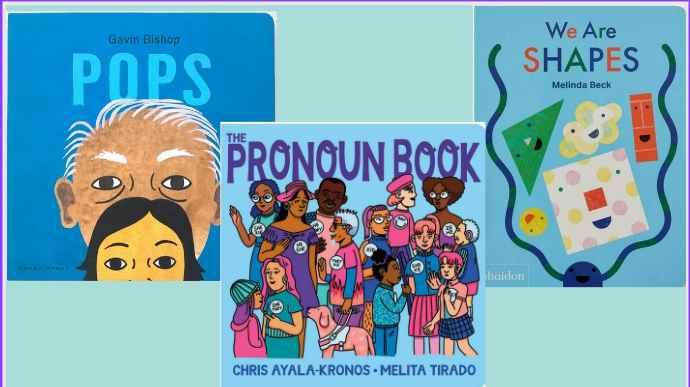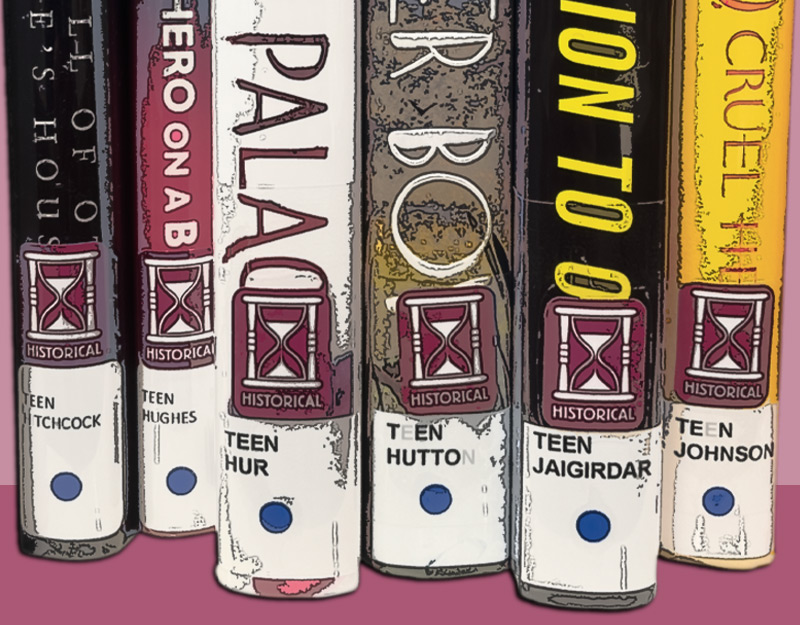Little Red Writing
Written by Joan Holub; Illustrated by Melissa Sweet
Published by Chronicle Books, 2013 (available Sept. 24)
ISBN# 9780811878692
Grades 2 and up
Book Review
Think you know the Little Red Riding Hood story, or even the many enjoyable alternative, fractured, and award-winning versions of it that populate the field of children’s literature? Acclaimed children’s writer Joan Holub and Caldecott and Sibert winning illustrator Melissa Sweet offer yet another delightfully fresh twist on the traditional tale in their forthcoming picturebook Little Red Writing (available Sept. 24). But this permutation is more than a cautionary tale: it’s actually a clever reflection and wise and witty guide for student writers. Little Red is an intrepid young pencil who sets out to complete a writing assignment for her teacher, Ms. 2, for Write On! Day at Pencilvania School. Armed with “a basket of 15 red words to use in case she ran into trouble” and Ms. 2’s counsel that “it’s OK to wander a little, but stick to your basic story path so you don’t get lost,” Little Red faces an onslaught of descriptive adjectives and adverbs, a run-on sentence that relentlessly pursues her, and other snares of the writer’s world. All of this happens, of course, in addition to her fateful encounter with the insatiable pencil sharpener known as the Wolf 3000. Jammed with sharp wordplay and puns, Holub’s text makes it almost impossible to suppress a chuckle. Sweet’s signature artistic style–packed with countless watercolor, pencil, and collage layers of detail and humor–adds incredible amounts of diversion to an already fun-filled book. In fact, much of the story, as well as the lessons for writing, get told through the illustrations. This is certainly a book that you and your students will return to over and over again–to read, explore, ponder, marvel at, and enjoy throughout the school year.
Teaching Ideas and Invitations
- Retelling Traditional Tales. Many of your students will know some version of the Little Red Riding Hood tale, whether it’s the Brothers Grimm version or a cultural version of the story. Using the SurLaLune Fairy Tale website (see Further Explorations section below) as your starting point, have students locate three picture book versions of a favorite folk or fairy tale. Have them compare and contrast the different representations of the story, drawing upon details in the text and the illustrations. Next, have them write their own original retelling in short story format. Make sure they pay attention to the craft of fiction, including dialogue. You can use Little Red Writing or one of the versions of Little Red Riding Hood listed below (see Further Explorations) as a mentor text, or you may also suggest they read an additional text from one of the many picture book versions of folk and fairy tales listed on the SurLaLune site.
- Precise Words. Joan Holub makes an important point about the use of precise nouns, verbs, adjectives, and adverbs when writing. How would the book or Little Red’s story read if they used more conventional words? Replace the verbs with ones more frequently used (or perhaps overused) by your students, and read the book aloud. Next, read the original language. How does it change the impact of the text? Have students take a piece of writing that they are already working on, highlight key words, and have them help one another brainstorm more interesting, precise, and descriptive choices.
- Puns and Wordplay. Holub plays with the fact that many words in the English language serve multiple grammatical purposes. For example, Little Red wanders to the gym and is “quickly drawn into the action,” a play on the fact that the characters are pencils. Encourage students to look through this book and others to identify such puns and wordplay. After discussing the phrases and sentences they find, have students try their own hand at playing with words that serve various syntactical purposes in their own writing.
- Using the Writing Advice. Little Red Writing is chock-full of sound advice for narrative writing. Invite students to focus on one of the bits of advice to apply to one narrative writing piece. Encourage them to try the suggestion that is offered in the book to revise their writing. Then have them share their pre- and post-revision versions of the story with a partner or small group for feedback.
- Language Arts- and Literacy-Related Holidays. Write On! Day may not be a real holiday, but a number of holidays that celebrate literacy and the language arts do exist. Have students research and compile a list of these holidays. Make sure they include information about when the holiday is celebrated, where it is celebrated, how it originated, and popular events and customs that take place and are practiced on that day. Use some of the websites listed below as possible resources for finding the information. Create a large calendar for the class that lists each of the holidays the students discover, and assign groups of students to be in charge of planning and leading the class in celebration of different holidays.
- Duet. Illustrator Melissa Sweet has another version of the Little Red Riding Hood story that she both wrote and illustrated, titled Carmine: A Little More Red (see Further Explorations below). Pair Little Red Writing with Carmine. What is similar and what is different about each version in terms of the story? How does Melissa Sweet’s illustrations compare and contrast in the two versions? How do the moods of each book compare and contrast? What questions do your students now have after reading both books? Use their questions as a entry-point into researching various aspects of the Little Red Riding Hood story. See our Teaching with Text Sets entry to learn more about the Duet Model.
Online Resources
Joan Holub’s website
http://www.joanholub.com
Melissa Sweet’s website
http://melissasweet.net
SurLaLune Fairy Tales
http://www.surlalunefairytales.com
Pun of the Day
http://www.punoftheday.com/cgi-bin/disppuns.pl?ord=F
ReadWriteThink.org Story Map
http://www.readwritethink.org/classroom-resources/student-interactives/story-30008.html
American Library Association List of Celebrations
http://www.ala.org/conferencesevents/celebrationweeks
ReadWriteThink.org Calendar of Celebrations and Activities
http://www.readwritethink.org/classroom-resources/calendar-activities/?main-tab=month#main-tabs
Other Language Arts and Literacy Holidays
http://litworld.org/worldreadaloudday/
http://www.nea.org/grants/886.htm
http://www.unesco.org/new/unesco/events/prizes-and-celebrations/celebrations/international-days/literacy-day/
http://www.poets.org/page.php/prmID/406
Books
Books about writing
Cronin, D. (2000). Click, clack, moo. New York: Atheneum Books for Young Readers.
Hills, T. (2012) Rocket writes a story. New York: Schwartz & Wade.
Kirk, D. (2007). Library mouse. New York: Abrams Books for Young Readers.
Nobisso, J. (2004). Show: Don’t tell!: Secrets of writing. Ill. by E. Montenari. New York: Gingerbread House.
Spinelli, E. (2008). The best story. Ill. by A. Wilsdorf. New York: Dial.
Stevens, J. (2011). The little red pen. Boston: Harcourt Children’s Books.
Some favorite versions of Little Red Riding Hood
Andersen, H. C., & Isadora, R. (1999). Little match girl. New York: Penguin Putnam Books for Young Readers.
Andersen, H. C., & Pinkney, J. (2002). Little match girl. New York: Puffin.
Artell, M. (2001). Petite Rouge: A Cajun Red Riding Hood. Ill. by Jim Harris. New York: Dial Books for Young Readers.
Browne, A. (2004). Into the forest. Somerville, MA: Candlewick Press.
Daly, N. (2007). Pretty Salma: A Little Red Riding Hood story from Africa. New York: Clarion Books.
Ernst, L. C. (1995). Little Red Riding Hood: A newfangled prairie tale. New York: Aladdin.
Forward, T. (2005). The wolf’s story: What really happened to Little Red Riding Hood. Ill. by I. Cohen. Somerville, MA: Candlewick Press.
Frisch, A. (2012). The girl in red. Ill. by R. Innocenti. Mankato, MN: Creative Editions.
Hyman, T. S. (1983). Little Red Riding Hood. New York: Holiday House.
Levine, G. C. (2010). Betsy Red Hoodie. Ill. by Scott Nash. New York: Harper.
Lowell, S. (1997). Little Red Cowboy Hat. Ill. by Randy Cecil. New York: Henry Holt and Co.
Marshall, J. (1987). Red Riding Hood. New York: Dial.
McKissack, P. (1986). Flossie & the fox. Ill. by Rachel Isadora. New York: Dial Books for Young Readers.
Sweet, M. (2005). Carmine: A little more red. New York: Houghton Mifflin.
Young, E. (1989). Lon Po Po: A Red Riding Hood story from China. New York: Penguin Putnam Books for Young Readers.
Filed under: Fiction Picture Books, Picture Books
About Grace Enriquez
Grace is an associate professor of language and literacy at Lesley University. A former English Language Arts teacher, reading specialist, and literacy consultant, she teaches and writes about children’s literature, critical literacies, and literacies and embodiment. Grace is co-author of The Reading Turn-Around and co-editor of Literacies, Learning, and the Body.
ADVERTISEMENT
ADVERTISEMENT
SLJ Blog Network
Name That LEGO Book Cover! (#53)
Cover Reveal and Q&A: The One and Only Googoosh with Azadeh Westergaard
K is in Trouble | Review
Fighting Public School Book Bans with the Civil Rights Act
ADVERTISEMENT








